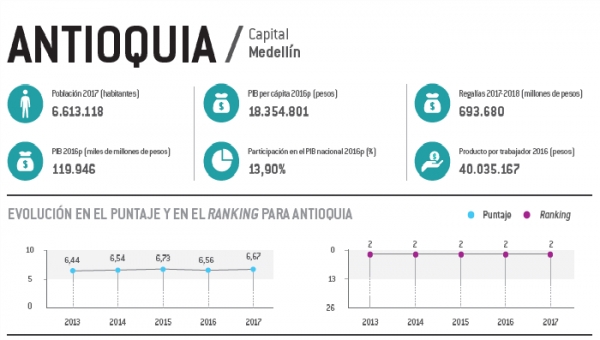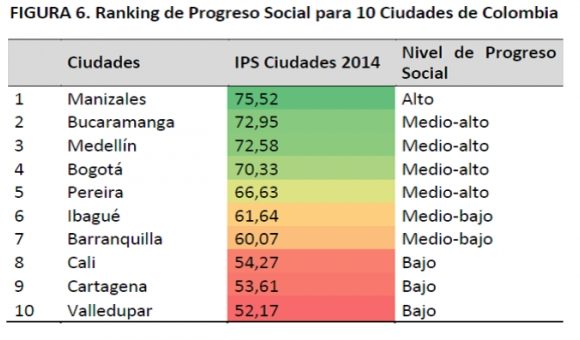Antioquia Continues to Rank High in Competitiveness: CPC Annual Study

A new study (see: https://idc.compite.com.co/) by the national private-sector competitiveness council (Consejo Privado de Competitividad, CPC) and Universidad del Rosario shows that Antioquia continues to rank near the top in competitiveness among all of Colombia’s 32 departments (states).
The departmental competitiveness index (Indice Departamental de Competitividad, IDC) — now in its fifth edition — shows that Antioquia ranks second only to Bogota in over-all competitiveness, with Santander third, Caldas fourth, Risaralda fifth, Valle del Cauca sixth, Cundinamarca seventh, Atlantico eighth, Boyaca ninth and Bolivar in 10th place.
Antioquia’s population of 6.6 million represents 13.9% of gross national product (PIB in Spanish intials), equivalent to COP$119.9 trillion (US$40 billion), while per-capita PIB is COP$18.3 million (US$6,135) and output per worker is COP$40 million (US$13,410), the study shows.
Besides coming-in second over-all in the national competitiveness ranking, Antioquia came-in third on institutional quality, fourth in infrastructure, second in market size, third in health-care, third in efficiency, third in higher education, second in market efficiency, second in innovation/sophistication and second in empresarial dynamism, the study shows.
However, Antioquia came-in at a relatively poor 18th in basic (primary and secondary) public schooling – down sharply from the 2013 survey — and only 19th in environmental sustainability, also down from 2013, the study shows.
The study analyzed 94 variables, grouped into three main categories: basic conditions, efficiency and innovation/sophistication.
Among the variables analyzed, Antioquia came in at 15th place in unemployment rate (9.62%), second in terms of worker contributions to health and pension funds (at 46.7%), second in terms of secondary-school English proficiency (34.12%), 18th in percent of total area in protected parks (10.7%), eighth in terms of total area covered by forests (34.6%), and sixth in per-capita financial investment in basic public education.
Antioquia came in at 15th place in terms of freight costs (transfers from cities to ocean ports), at US$68.84 per tonne of freight. Antioquia’s decades-long backlog and delays in building divided highways through its mountainous terrain explain the relatively poor freight-cost competitiveness, compared to cities nearer the Atlantic and Pacific ports.
Notably, despite claims by certain politicians, Antioquia is among the best departments in all Colombia in terms of long-term contract electricity costs (mainly for industry), at COP$290 per kiloWatt-hour, the study shows.
In the report, Jaime Echeverri, vice-president of planning and development for the Medellin Chamber of Commerce for Antioquia, pointed to greater economic diversification and greater focus on value-added production in Antioquia over the past 10 years.
This diversification “has been supported by the cluster strategy, in which public-private cooperation and the commitment of companies have been important assets,” according to Echeverri.
“This strategy prioritized six clusters: electric power; business tourism, fairs and conventions; building; medicine and odontology services; technology, information and communications; and textile clothing, design and fashion.
“The cluster model has focused on generating environmental conditions that favor competitiveness and productivity, around aspects such as innovation, science and technology, education, institutionality, human resources, as well as strengthening of the business base for taking advantage of business opportunities in high-potential segments.
“In a recent context, and with emphasis on the subregions of the department, the model of productive chains is being developed, in which business initiatives around coffee, cocoa and dairy products have been prioritized, and progress is being made in citrus and rubber, among others.
“In terms of diversification of the export basket, and of export destination countries, the region now has the ‘Grupo Antioquia Exporta Más’ [Antioquia Exports More] initiative, which integrates the entities related to the internationalization of companies — and this is supported by the Ministry of Commerce, Industry and Tourism.
“This initiative seeks to integrate efforts and resources, and generate synergies in face of the challenges faced by the export base of the region, by advancing in an orderly manner on different fronts: country cost, market opening and expansion, design and development of products and services , business strengthening, human talent, financing, promotion of export culture and development of strategic capabilities,” Echeverri concluded.
















